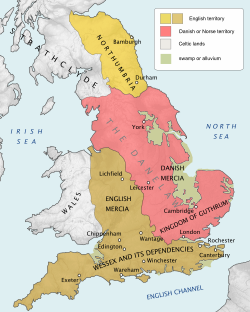Terms
There is more than one version of the treaty recorded. The original documents were written in Old English. [d] The following version was translated by Frederick Attenborough:
Prologue: These are the terms of peace which King Alfred and King Guthrum, and the councillors of all the English nation, and all the people who dwell in East Anglia, have all agreed upon and confirmed with oaths, on their own behalf and for their subjects both living and unborn, who are anxious for Gods favour and ours.
- First as to the boundaries between us. [They shall run] up the Thames, and then up [e] the Lea, and along the Lea to its source, [f] then in a straight line to Bedford, and then up the Ouse to Watling Street.
- Secondly, if a man is slain, whether he is an Englishman or a Dane, all of us shall place the same value on his life — namely 8 half-marks [g] of pure gold, with the exception of commoners who occupy tributary land, [h] and freedmen of the Danes. These also shall be valued at the same amount — [namely] 200 shillings — in either case.
- If anyone accuses a king's thegn of homicide, if he dares to clear himself, he shall do so with [the oaths of] twelve king's thegns. If anyone accuses a man who belongs to a lower order than that of king's thegn, he shall clear him-self with [the oaths of] eleven of his equals and one king's thegn. And this law shall apply to every suit which involves an amount greater than 4 mancusses. [i] And if he [the accused] dare not [attempt to clear himself], he shall pay [as compensation] three times the amount at which the stolen property is valued.
- Every man shall have knowledge of his warrantor when he buys slaves, or horses, or oxen.
- And we all declared, on the day when the oaths were sworn, that neither slaves nor freemen should be allowed to pass over to the Danish host without permission, any more than that any of them [should come over] to us. If, however, it happens that any of them, in order to satisfy their wants, wish to trade with us, or we [for the same reason wish to trade] with them, in cattle and in goods, it shall be allowed on condition that hostages are given as security for peaceful behaviour, and as evidence by which it may be known that no treachery is intended.
— Attenborough 1922, pp. 96–101

